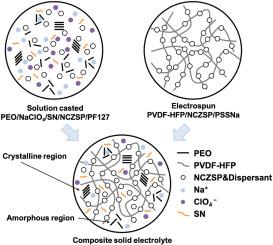Electrospun nanofiber reinforced ceramic-polymer composite solid electrolyte membrane for sodium batteries
IF 14.2
1区 材料科学
Q1 ENGINEERING, MULTIDISCIPLINARY
引用次数: 0
Abstract
This paper presents a novel ceramic-polymer composite solid electrolyte (CSE) for sodium metal batteries. The CSE was fabricated by infusing a poly(ethylene oxide) (PEO)-based electrolyte containing PEO, NaClO4, succinonitrile (SN), Na3.2Ca0.1Zr1.9Si2PO12 (NCZSP), and Pluronic F127 (PF127) into an electrospun nanofibrous structure composed of poly(vinylidene fluoride-co-hexafluoropropylene) (PVDF-HFP), NCZSP, and poly(sodium 4-styrenesulfonate) (PSSNa). Effective dispersion of NCZSP in both the PEO and PVDF-HFP systems was achieved by incorporating dispersants PF127 and PSSNa. In this design, the PEO/NaClO4/SN/NCZSP/PF127 blend established a continuous and highly ionic conductive pathway within the high-strength structure of the electrospun PVDF-HFP/NCZSP/PSSNa, resulting in improved ionic conductivity without compromising the mechanical strength. After optimization, the solid electrolyte, named SC-30/ES-30, possesses high ionic conductivity (3.02 × 10−4 S cm−1), good mechanical strength (6.49 MPa), a wide electrochemical stability window (6 V vs. Na/Na+), high sodium-ion transference number (0.62), and exceptional stability during sodium stripping and plating. In the battery performance evaluation, the solid-state sodium metal battery Na3V2(PO4)3@C|SC-30/ES-30|Na exhibited a high capacity of 105.8 mAh g−1 and remarkable cyclic retention of 80.5 % after 500 cycles under a current density of 0.2C. These findings suggest that SC-30/ES-30 has great potential for practical applications.

钠电池用静电纺丝纳米纤维增强陶瓷-聚合物复合固体电解质膜
提出了一种用于钠金属电池的新型陶瓷-聚合物复合固体电解质(CSE)。将含有PEO、NaClO4、丁二腈(SN)、Na3.2Ca0.1Zr1.9Si2PO12 (NCZSP)和Pluronic F127 (PF127)的聚环氧乙烷(PEO)基电解质注入聚偏氟乙烯-共六氟丙烯(PVDF-HFP)、NCZSP和聚4-苯乙烯磺酸钠(PSSNa)组成的电纺丝纳米纤维结构中,制备了CSE。通过加入分散剂PF127和PSSNa, NCZSP在PEO和PVDF-HFP体系中均实现了有效分散。在本设计中,PEO/NaClO4/SN/NCZSP/PF127共混物在静电纺PVDF-HFP/NCZSP/PSSNa的高强度结构内建立了连续的高离子导电性通路,在不影响机械强度的情况下提高了离子导电性。优化后的固体电解质SC-30/ES-30具有较高的离子电导率(3.02 × 10−4 S cm−1)、良好的机械强度(6.49 MPa)、较宽的电化学稳定窗口(6 V vs. Na/Na+)、较高的钠离子转移数(0.62)以及优异的钠剥离和镀镀稳定性。在电池性能评价中,固态金属钠电池Na3V2(PO4)3@C|SC-30/ES-30|Na在电流密度为0.2C的条件下,循环500次后的容量高达105.8 mAh g - 1,循环保留率高达80.5%。这些发现表明SC-30/ES-30具有很大的实际应用潜力。
本文章由计算机程序翻译,如有差异,请以英文原文为准。
求助全文
约1分钟内获得全文
求助全文
来源期刊

Composites Part B: Engineering
工程技术-材料科学:复合
CiteScore
24.40
自引率
11.50%
发文量
784
审稿时长
21 days
期刊介绍:
Composites Part B: Engineering is a journal that publishes impactful research of high quality on composite materials. This research is supported by fundamental mechanics and materials science and engineering approaches. The targeted research can cover a wide range of length scales, ranging from nano to micro and meso, and even to the full product and structure level. The journal specifically focuses on engineering applications that involve high performance composites. These applications can range from low volume and high cost to high volume and low cost composite development.
The main goal of the journal is to provide a platform for the prompt publication of original and high quality research. The emphasis is on design, development, modeling, validation, and manufacturing of engineering details and concepts. The journal welcomes both basic research papers and proposals for review articles. Authors are encouraged to address challenges across various application areas. These areas include, but are not limited to, aerospace, automotive, and other surface transportation. The journal also covers energy-related applications, with a focus on renewable energy. Other application areas include infrastructure, off-shore and maritime projects, health care technology, and recreational products.
 求助内容:
求助内容: 应助结果提醒方式:
应助结果提醒方式:


